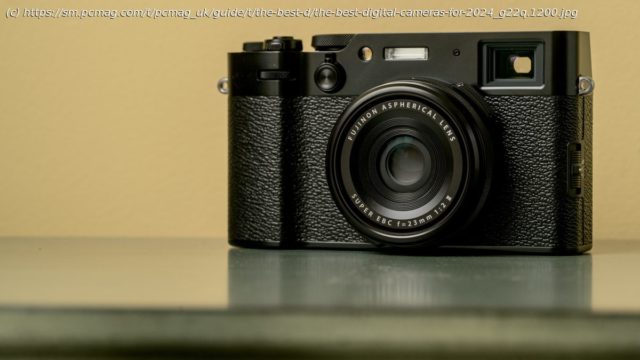We test and rate scores of digital cameras and lenses each year, from pocket-friendly models to high-end medium format systems. Here’s everything you need to know to pick the best camera for you.
Are you shopping for a digital camera but don’t know where to start? We’re here to help. PCMag has been covering digital cameras for over 20 years, and our experts have extensive hands-on experience with every system. We test cameras both inside of our photo studio and out in the real world to determine which ones perform the best. Our reviews are independent and free of outside influence from camera makers—you won’t see any sponsored opinions here, just straight talk from our photo experts.
Cameras come in all shapes and sizes, and this list covers the gamut. Whether you’re shopping for a small action camera, something for vlogging, or a full-frame mirrorless model, you can find the right one to suit your needs. If you want the best of the best, look no further than the stunning Fujifilm X100VI fixed-lens compact. It earns a very rare five-star rating, so you can be sure it’s exceptional all around. But there are plenty of other Editors‘ Choice winners on the list that might appeal more depending on your interests. Make sure to click through to our in-depth reviews of each model and read to the end for some helpful buying advice. We’re always reviewing the latest and greatest cameras, so check back often to see if there’s a new one that suits your fancy.Why We Picked It
The X100VI is one of the few fixed-lens cameras that’s as good as swappable-lens options in terms of picture quality and handling. Though not quite pocket-sized, the camera is still quite small and light. Its bright prime lens includes an integrated ND filter to support creative exposures, while a stabilized 40MP APS-C image sensor provides a useful digital crop so you can shoot at a standard or short telephoto angle. The X100VI also looks and feels like an old film camera; serious photographers will love its hybrid optical-electronic viewfinder and discrete shutter, aperture, and exposure controls. Simply put, you can’t find a better fixed-lens camera today.Who It’s For
Photographers who don’t always want to carry a big mirrorless camera are the X100VI’s main demographic. But there’s also plenty of appeal for former smartphone creators who want to avoid fiddling with changeable lenses or simply appreciate a camera that oozes style. The only problem is finding one in stock; demand for the X100VI exceeds the current supply, so be prepared to wait on a backorder list if you’re champing at the bit to get one.Why We Picked It
The Canon EOS R6 Mark II is our favorite full-frame camera for most people. It snaps attractive 24MP photos and has a class-leading autofocus system that smartly recognizes people, animals, and vehicles. With 12fps (mechanical) and 40fps (electronic shutter) bursts available, it’s especially suitable for action shots, while stabilized 4K60 video should please filmmakers and vloggers.Who It’s For
If you want a full-frame camera, the R6 Mark II should be near the top of your list. The big sensor means you can get soft, defocused backgrounds, while the best-in-class autofocus system ensures wildlife and sports specialists won’t miss their shots. It’s also an easy sell if you already own Canon SLR or RF lenses. Creators with Sony glass can look to the a7 IV as an alternative because it offers competitive performance for the same price.Why We Picked It
The Nikon Z 8 matches a high-resolution 45MP Stacked CMOS sensor with an autofocus engine that can track subjects at 20fps, a combination that’s ideal for everything from wedding and fashion events to sports and wildlife capture. A midsize, weather-sealed body, brilliant EVF, and support for both Raw and ProRes video round out the feature set.Who It’s For
The Z 8 is for professionals who use a camera to make a living, as well as knowledgeable enthusiasts. Its high-pixel sensor offers the broad dynamic range and resolution that landscape and architectural photography requires, while in-body stabilization, fast focus, and excellent low-light performance are ideal for events and action. Nikon has a full series of Z mirrorless lenses that work with the camera, too.Why We Picked It
The Fujifilm X-S20 is a near-ideal camera for content creators and photo enthusiasts alike. It puts Fuji’s X-Trans color science into a magnesium body with familiar controls, long battery life, and a swing-out LCD for vlogging. A stabilized sensor and an extensive lens library make it a favorite for travel and anyone who wants options when it comes to glass. The only real knock against it for travel is the lack of weather protection.Who It’s For
We like the X-S20 for photo hobbyists who can take advantage of Fuji’s large library of dedicated APS-C lenses, as well as content creators who want to make YouTube videos or short films. Event photogs should look to a higher-tier model with dual card slots, however, such as the Canon EOS R7 or Fuji X-T5.Why We Picked It
The GoPro Hero12 Black is the camera to beat for video-first creators who want to document outdoor adventures, dives, and extreme sports, as well as just make vlogs. It supports 5.3K60 and 4K120 capture, records incredibly stable footage without the need for a gimbal, and is small enough to mount pretty much anywhere. The 8:7 format sensor offers flexibility to pull out 16:9 and 9:16 video from the same clip. Optional accessories like the Media Mod cage and microphone, as well as the ultra-wide Max Lens 2.0 mod, make it a bit more versatile than budget action cams. We also like that it’s waterproof to 33 feet.Who It’s For
GoPro started as a brand for surfers, so if Point Break is your favorite movie, consider yourself in the target market. Video-first adventure seekers should find the Hero12 ideal for slow-motion action shots, while vloggers should appreciate the front-facing color monitor and moving time-lapse mode.Why We Picked It
The Lumix G9 II is the best Micro Four Thirds camera we’ve tested. Its sensor goes toe-to-toe with larger-format competitors in picture quality, while its huge lens library gives creators plenty of flexibility. A stabilized sensor, 10-bit 5.7K60 video capture, and a sturdy all-weather build make it a good choice for video, location, and outdoor use. We also like the revamped autofocus system that integrates phase detection pixels for high-speed capture with subject tracking.Who It’s For
The Micro Four Thirds system makes sense for photographers who prefer to carry a lighter overall kit. Yes, the G9 II is built around a full-frame chassis, but it’s still light at 1.4 pounds and balances well with a lot of compact lenses from Panasonic, OM System, and others. It’s also great for hybrid creators thanks to its excellent video toolkit.Why We Picked It
The Sony ZV-E1 is the best full-frame camera you can get for vlogging. Its big sensor records video with blurred-out backgrounds, as well as includes stabilization to support steady handheld recording. The 12MP pixel count is somewhat meager but supports pixel-for-pixel readout for the best 4K video from a small camera. A quality in-camera mic sets it apart from mainstream photo cameras like the a7 IV. There are loads of lenses available too, with plenty of both affordable and high-end options. Third-party lens makers, including Sigma and Tamron, bolster Sony’s FE lens line.Who’s It For
If you’ve got a YouTube channel or aspire to have one, the ZV-E1 should be on your short list. It’s especially suitable if you plan to serve both as the on-screen talent and the camera operator. The ZV-E1 includes some tracking and zoom-in options to add Ken Burns-style motion to shots, meaning you can let the camera handle movements and concentrate on the content of your video. Its small size and weather-sealed body are equally useful for location shots and those in the studio.Why We Picked It
The compact, vlog-friendly DJI Osmo Pocket 3 puts a wide-angle 20mm lens and a 4K video camera on a three-axis gimbal that enables rock-steady handheld footage. It also supports 4K60 recording with sound and 120fps slow-motion in widescreen mode, as well as manages a quality 3K picture in a vertical aspect ratio. The Pocket’s Type 1 sensor works well in dim light and supports 2x lossless digital zoom for scenes in which the prime lens is a little too wide.Who It’s For
The Osmo Pocket 3 is first and foremost a video camera. It snaps stills, sure, but its gimbal-stabilized video is the main appeal. You should get it for self-recorded videos, travel logs, and documentary-style footage. We recommend spending more on the Creator Combo ($669) if you’re after a turnkey vlogging solution as it adds an extended life battery and a wireless lapel mic for longer shoots with crystal clear sound. Just remember that the Pocket is not rugged or waterproof, so it won’t replace your action cam.Why We Picked It
The Sony a6700 is the best APS-C camera that works with Sony’s huge E-mount lens library. Its top-notch autofocus system supports snappy 11fps subject tracking and works well for 4K60 video.






